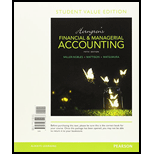
Concept explainers
1. (a)
No-par common stock: The common stock that is issued at its fair market value is known as no-par common stock. Common stock are the ordinary shares that a corporation issues to the investors in order to raise funds. In return, the investors receives a share of profit from the profits earned by the corporation.
Stated value: It refers to the appropriate value of the stock determined by the board of directors of a corporation for accounting purposes.
To record: the
(b)
To Journalize: the issuance of common stock for S Company.
2.
To find: which type of stock results in more total paid-in capital.
Want to see the full answer?
Check out a sample textbook solution
Chapter 13 Solutions
Horngren's Financial & Managerial Accounting, Student Value Edition (5th Edition)
- QUESTION: On June 30, 2009, Sideways Movers had $243,000 in current assets and $211,000 in current liabilities. On August 1, 2009, Sideways received $50,000 from an issue of promissory notes that will mature in 2012. The notes pay interest on February 1 at an annual rate of 6 percent. Sideways' fiscal year ends on December 31. What is the interest expense for December 31?arrow_forwardDetermine the gross income of this financial accounting questionarrow_forwardwhat is the balance in the supplies account after adjustmentarrow_forward
- Principles of Accounting Volume 1AccountingISBN:9781947172685Author:OpenStaxPublisher:OpenStax College
 Financial Accounting: The Impact on Decision Make...AccountingISBN:9781305654174Author:Gary A. Porter, Curtis L. NortonPublisher:Cengage Learning
Financial Accounting: The Impact on Decision Make...AccountingISBN:9781305654174Author:Gary A. Porter, Curtis L. NortonPublisher:Cengage Learning  Intermediate Accounting: Reporting And AnalysisAccountingISBN:9781337788281Author:James M. Wahlen, Jefferson P. Jones, Donald PagachPublisher:Cengage Learning
Intermediate Accounting: Reporting And AnalysisAccountingISBN:9781337788281Author:James M. Wahlen, Jefferson P. Jones, Donald PagachPublisher:Cengage Learning



